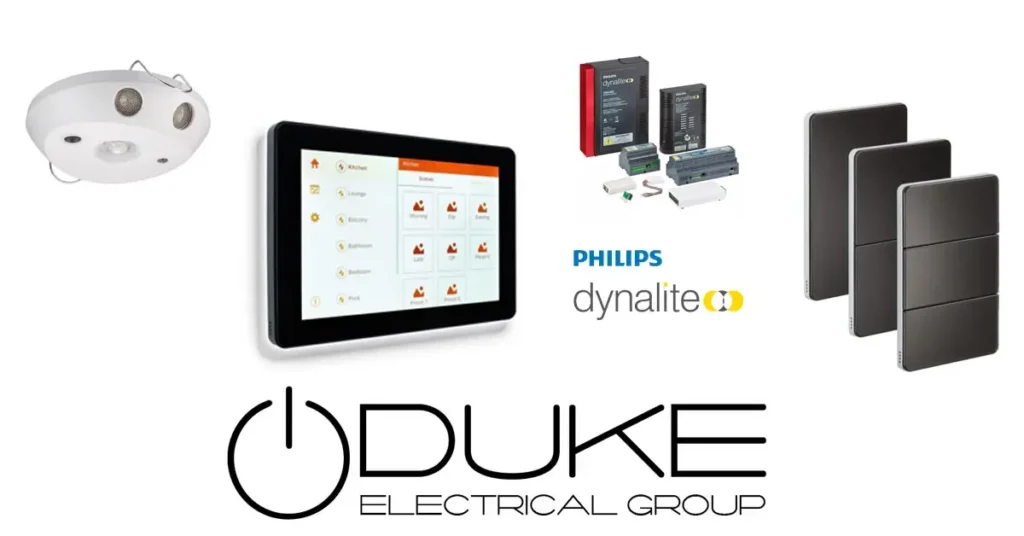What is Philips Dynalite?
Philips Dynalite is a globally recognised advanced lighting control platform with over 35 years of reliable service in more than 35,000 projects worldwide. Originally developed in Australia and now part of Signify (formerly Philips Lighting), Dynalite provides intelligent lighting management through a flexible, modular architecture that can be tailored to the specific needs of any project. The system utilises the proprietary DyNet protocol to enable seamless communication between lighting fixtures, sensors, controllers, and user interfaces, creating cohesive and responsive lighting environments.
Why should I choose Philips Dynalite for my lighting control system?
Philips Dynalite offers unparalleled reliability, flexibility, and energy efficiency for your lighting control needs. With a proven track record spanning over three decades and installations in prestigious projects worldwide, including the Burj Khalifa in Dubai, Dynalite delivers consistent performance in environments of any scale. DUKE Electrical Group’s certified technicians ensure your Dynalite system is professionally installed and configured to meet your specific requirements, providing precise control, significant energy savings, and seamless integration with other building systems. The system’s distributed architecture minimises the risk of system-wide failures, ensuring higher reliability and faster response times across your entire network.
What makes Philips Dynalite different from other lighting control systems?
Philips Dynalite distinguishes itself through its distributed intelligence architecture, where each device in the system has its own processing capability, allowing it to operate independently even if communication with other parts of the system is interrupted. Unlike centralised systems that can fail completely if the main controller malfunctions, Dynalite’s approach ensures greater reliability and system resilience. Additionally, Dynalite offers exceptional scalability, supporting projects from single rooms to entire building complexes without changing the core technology. The system’s Australian design and manufacturing heritage ensures robust quality control, while its comprehensive integration capabilities with third-party systems provide a truly holistic approach to building management that many competing systems cannot match.
How does Philips Dynalite save energy?
Philips Dynalite saves energy through multiple intelligent strategies working in concert. The system leverages occupancy sensing to automatically turn lights off in unoccupied spaces, while daylight harvesting sensors adjust artificial lighting levels based on available natural light, maintaining optimal brightness while minimizing power consumption. Time-based scheduling ensures lights operate only when needed, and task-appropriate lighting scenes prevent energy waste from over-illumination. Dynalite’s precise dimming capabilities further reduce energy usage, as even small reductions in light output can yield significant power savings. The system’s monitoring and reporting features allow building managers to analyze usage patterns and optimize settings for maximum efficiency, typically resulting in 30-60% energy savings compared to conventional lighting systems.
Is Philips Dynalite suitable for both residential and commercial projects?
Philips Dynalite is exceptionally versatile and equally well-suited for both residential and commercial applications. In homes, the system creates personalized lighting environments that enhance comfort and ambiance while offering convenient control through elegant wall panels, touchscreens, or mobile devices. Homeowners appreciate the energy savings, scene-setting capabilities, and integration with home automation systems. For commercial spaces such as offices, retail environments, hotels, and public buildings, Dynalite provides sophisticated management of lighting across multiple zones, floors, or buildings, with features like occupancy-based control, daylight harvesting, and scheduled operation that significantly reduce operational costs. The scalable nature of Dynalite means the same core technology can be applied effectively to a luxury residence or a large-scale commercial development, with DUKE Electrical Group customizing the implementation to suit the specific requirements of each project.
Can Philips Dynalite be integrated with other building systems?
Philips Dynalite excels at integration with other building systems through standard protocols and dedicated gateway devices. The system seamlessly connects with HVAC, security, AV systems, and building management systems (BMS) using protocols like DALI, BACnet, and KNX. This integration enables comprehensive building automation where lighting responds to broader environmental conditions and user activities. For example, when integrated with security systems, lights can automatically activate when an alarm is triggered, or when connected to HVAC controls, both systems can respond to occupancy detection for optimized energy management. DUKE Electrical Group specializes in creating these integrated solutions, ensuring that your Dynalite system works harmoniously with existing or new building technologies to create intelligent environments that enhance comfort, efficiency, and functionality.
What is distributed control, and why is it important in Philips Dynalite?
Distributed control is a fundamental architectural principle in Philips Dynalite where intelligence is spread throughout the system rather than concentrated in a central processor. Each device—whether a controller, sensor, or user interface—contains its own processing capability and can operate independently while still communicating with the network. This approach is crucial because it eliminates single points of failure that plague centralized systems; if one component fails, the rest of the system continues to function normally. Distributed control also enables faster response times since commands are processed locally rather than routed through a central hub. Additionally, this architecture makes the system inherently scalable and flexible, allowing for easy expansion and reconfiguration without requiring complete system redesigns. DUKE Electrical Group leverages this distributed architecture to create robust, reliable lighting control systems that maintain functionality even in challenging conditions.



